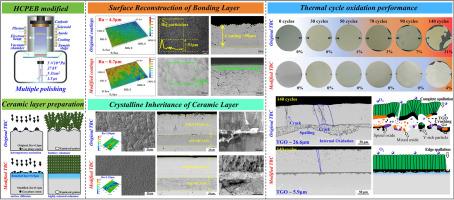通过大电流脉冲电子束处理提高热障涂层的使用寿命:键合层的表面重构和陶瓷层的结晶继承
IF 14.3
1区 材料科学
Q1 MATERIALS SCIENCE, MULTIDISCIPLINARY
引用次数: 0
摘要
热障涂层(TBC)是航空发动机的一项关键热防护技术。控制TBC界面的结构稳定性和抑制热生长氧化物(TGO)的不受控制的生长一直是该领域的挑战。本文介绍了一种利用大电流脉冲电子束(HCPEB)技术协同控制TBC体系中金属/陶瓷界面形貌和微观结构的创新方法,旨在实现TGO的稳态生长,延长TBC的使用寿命。在本研究中,采用HCPEB辐照对电弧离子镀MCrAlYX金属涂层进行改性,诱导涂层表面重熔抛光和微观结构重建。这种处理有效地将表面粗糙度降低了约83%,并消除了颗粒团簇和微裂纹等缺陷。采用电子束-物理-气相沉积法制备了YSZ陶瓷涂层,该重熔层具有精细的微观结构,厚度约为7 μm。结果表明,形成的陶瓷涂层具有更均匀的柱状晶粒,粗糙度降低。1100℃的热循环氧化测试表明,hcpeb修饰的TBC在界面处形成了致密、稳定的al2o3基TGO层,提高了抗氧化性,抑制了剥落。改进后的TBC系统的结构完整性和界面稳定性增强,有助于显著延长热循环寿命,突出了HCPEB在推进高温TBC应用方面的有效性。本文章由计算机程序翻译,如有差异,请以英文原文为准。

Enhancing service life of thermal barrier coating via high-current pulsed electron beam processing: Surface reconstruction of bonding layer and crystalline inheritance of ceramic layer
Thermal barrier coating (TBC) is a critical thermal protection technology in aerospace engines. Controlling the structural stability of the TBC interface and suppressing the uncontrolled growth of thermally grown oxide (TGO) have long been challenges in this field. This work introduced an innovative method to synergistically control the morphology and microstructure of the metal/ceramic interface in the TBC system using high-current pulsed electron beam (HCPEB) technology, aiming to achieve steady-state growth of TGO and extend the service life of TBC. In this study, an arc-ion-plated MCrAlYX metallic coating was modified by HCPEB irradiation to induce remelting-polishing and microstructure reconstruction of the coating surface. This treatment effectively reduced surface roughness by approximately 83% and eliminated defects such as particle clusters and microcracks. The remelted layer, with a refined microstructure and a thickness of approximately 7 μm, was used to control the genetic growth behavior of the YSZ ceramic coating deposited by electron beam-physical-vapor deposition. As a result, the ceramic coating formed with more uniform columnar grains and reduced roughness. Thermal cycling oxidation testing at 1100°C demonstrated that the HCPEB-modified TBC produced a dense, stable Al2O3-based TGO layer at the interface, improving oxidation resistance and suppressing spallation. The enhanced structural integrity and interface stability of the modified TBC system contribute to a significantly extended thermal-cycling lifespan, highlighting the effectiveness of HCPEB in advancing TBC for high-temperature applications.
求助全文
通过发布文献求助,成功后即可免费获取论文全文。
去求助
来源期刊

Journal of Materials Science & Technology
工程技术-材料科学:综合
CiteScore
20.00
自引率
11.00%
发文量
995
审稿时长
13 days
期刊介绍:
Journal of Materials Science & Technology strives to promote global collaboration in the field of materials science and technology. It primarily publishes original research papers, invited review articles, letters, research notes, and summaries of scientific achievements. The journal covers a wide range of materials science and technology topics, including metallic materials, inorganic nonmetallic materials, and composite materials.
 求助内容:
求助内容: 应助结果提醒方式:
应助结果提醒方式:


